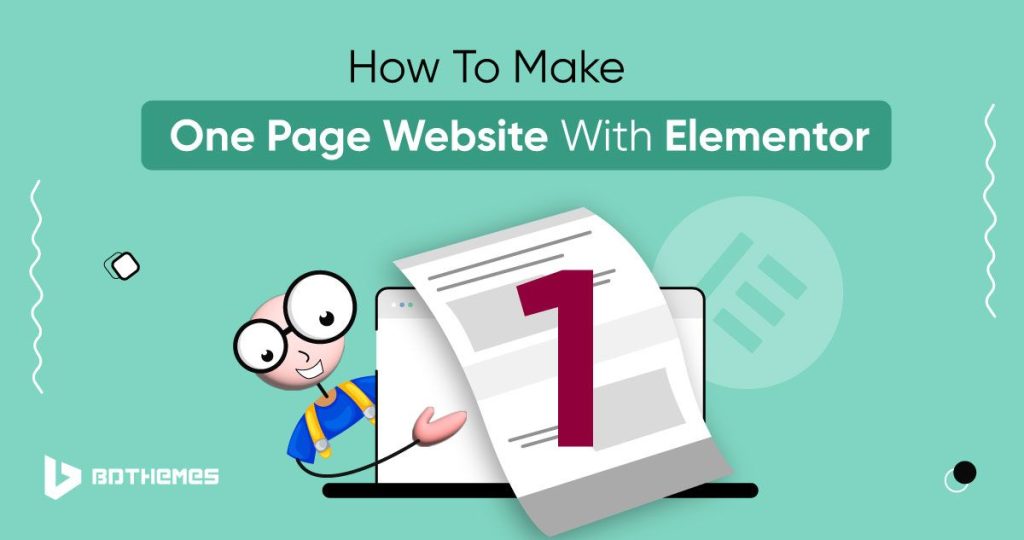Looking for how to create a one-page website with Elementor? You have dropped to the right pace!
Creating a one-page website for anyone can be easy. Only if you know what is Elementor and WordPress and how both work.
This blog post covers, how you can easily create a one-page website in WordPress with Elementor.
What Is A One-Page Website?
A one-page website is referred to as a single-page website.
Usually, websites consist of multiple pages.
But a One-page website is a single page where each section contains minimal but necessary information.
The visitors can easily navigate through different sections just by scrolling down.
Why Create A One-Page Website?
A single, super-focused webpage that does the job neatly. No need to jump around from one page to another.
If a website has multiple pages, a visitor gets confused and puzzled. But a one-page navigation guides them straight to the point.
How To Create One-Page Website With Elementor From Template
Creating a one-page website with Elementor from a template is a great way to quickly set up a stylish and functional site. Follow these steps to get started:
Step 1: Choose a Compatible Theme
Choose a theme that’s compatible with Elementor. Many themes work well, but it’s best to use one designed for compatibility with Elementor for a smoother experience.
- Go to Appearance
- Then select Themes
- Now add a new theme.
Step 2: Access Elementor Templates
- In your WordPress dashboard, go to “Pages” > “Add New” to create a new page.
- Give your page a title, like “Home” or “One-Page Website.”
- Click the “Edit with Elementor” button.
Step 3: Choose a Template
- Once you’re in the Elementor editor, click the folder icon on the bottom panel (Template Library).
- Browse through the template library to find a single page template that suits your website’s purpose. You can search for specific keywords, e.g., “single page,” to narrow down your choices.
- Click on a template to preview it.
Step 4: Import the Template
- After selecting a template, click the “Insert” button.
- Elementor will import the template onto your page.
Step 5: Customize the Template
- Now, you can customize the template to match your brand and content.
- Click on any element to edit text, images, or other content. You can also rearrange sections or add new ones.
- To change styles, fonts, colors, and more, use the Elementor Style tab and settings for individual elements.
- Don’t forget to replace template images and text with your own content.
- For a dynamic look, add background color or background image.
- You can use footer template by changing the contents only.
Step 6: Save and Publish
- As you make changes, be sure to click the “Save” button regularly to save your progress.
- Once you’re satisfied with your one-page website, click the “Publish” button to make it live.
Step 7: Set as Homepage (Optional)
- If you want your one-page website to be your homepage, navigate to “Settings” > “Reading” in the WordPress dashboard.
- Under “Your homepage displays,” select “A static page”
- In the “Homepage” choose the page you just created.
How To Create One-Page Website Manually Create A Page
Creating a one-page website manually with the specific sections using Elementor is straightforward. Here’s a step-by-step guide:
Step 1: Install Elementor and Choose a Theme
Ensure you have the Elementor plugin installed on your WordPress site and select a compatible theme.
Step 2: Create a New Page
- In your WordPress dashboard, navigate to “Pages” > “Add New.”
- Give your page a title, like “One-Page Website.”
Step 3: Enable Elementor
Click the “Edit with Elementor” button to start building your page.
Step 4: Create the Navbar
- To create a navigation bar for dropdown menu items, add a section by clicking the gray “+ Section” button.
- Add a row with columns for your navigation links. You can use text widgets or custom HTML to create the links.
- Customize the styling of the navbar to make it look like a traditional navigation bar.
- Save the menu and proceed.
Step 5: Create the Header
- Below the navbar, add a new section.
- Add a row and columns for your header content. This could include a headline, subheadline, and a call-to-action button.
- Customize the header’s appearance and style as desired.
Step 6: Add an Additional Section
- Continue by adding additional sections below the header for your content. To do this, add new sections, rows, and columns as needed.
- Populate each section with relevant content, such as text, images, and buttons.
- Customize the styling of each section according to your design preferences.
Step 7: Create the Testimonial Section
- Add a new section for testimonials.
- Add rows and columns to showcase testimonials.
- Use Elementor widgets to display individual testimonials, including text and images. Try using testimonial carrousel.
- Style the testimonial section to make it visually appealing.
Step 8: Create the Price Section
- Below the testimonial section, add another new section.
- Design this section to display pricing information. You can use columns and widgets to list different pricing options.
- Customize the appearance and style of this section, including pricing tables or cards.
Step 9: Design the Footer
- Finally, create a footer section at the bottom of your page.
- Add rows and columns for footer content, such as contact information, social media links, and copyright details.
- Style the footer to match your overall design.
Step 10: Publish Your One-Page Website
Once your attractively designed website is done, check screen responsiveness for mobile users. Click on the eye icon and watch the preview. Once you’re satisfied with your one-page website, click the Publish button to make it live.
Step 11: Set as Homepage (Optional)
- If you want your one-page website to serve as your homepage, navigate to “Settings” > “Reading” in the WordPress dashboard.
- Under “Your homepage displays,” select “A static page” and choose the page you just created.
- Click on save changes.
Regular Updates And Maintenance
Regular updates and maintenance ensure that your website remains up-to-date with the latest software, theme builder, themes, and plugins. This helps to improve functionality, fix bugs, and enhance security.
- You need to monitor your website analytics by tracking visitor data, behavior, and engagement on your site. This helps you understand your audience and measures the effectiveness of your content. It also helps you make data-driven decisions for improvements.
- Optimizing loading speed provides a positive user experience by reducing load time. A fast-loading website reduces bounce rates keeping your visitors engaged. This boosts your search engine rankings.
- Implementing security measures is crucial to protect your website from cyber threats and attacks. Security measures include using firewalls, strong passwords, and security plugins to safeguard sensitive data. This maintains the integrity of your site.
Final Thoughts
Creating a one-page website with Elementor and WordPress is an effective way to establish your online presence.
Elementor and WordPress are a dynamic combination for static website creation. And adding plugins makes your online presence more noticeable and visually engaging.
Happy website building!
Frequently Asked Questions
How Can I Make A One Page Website For Free
To create a one-page website for free, you can use platforms like WordPress or website builders like Wix or Weebly, which offer free plans. Install WordPress, choose a one-page theme, and use plugins like Elementor for easy customization.
How Many Websites Can I Make With Elementor
To create a one-page website for free, you can use platforms like WordPress or website builders like Wix or Weebly, which offer free plans. Install WordPress, choose a one-page theme, and use plugins like Elementor for easy customization.
How Do I Make An Entire Page A Template In Elementor?
To make an entire page a template in Elementor, create or edit the page you want to save as a template. In the Elementor editor, click the folder icon at the bottom panel (Template Library). It is also called the Template button. Select “Save as Template,” provide a name, and save it. You can then apply this template to other pages.
How Do I Import Only One Page Into WordPress?
You can’t import a single page directly into WordPress; WordPress usually imports entire websites or posts/pages. To add content to a specific page, create or edit the page in WordPress, and paste the content manually.







